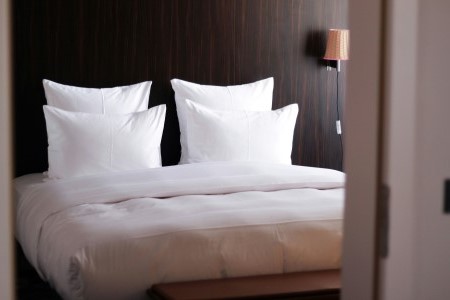Disclaimer
MFS are a bridging loan and buy-to-let mortgage provider, not financial advisors. Therefore, Investors are encouraged to seek professional advice.
The information in this content is correct at time of writing.

Becoming a landlord can be incredibly lucrative. Even considering the recent difficulties afflicting the market. Yields are holding steady, and demand for rental property shows few signs of slowing down. But, property investors need to remember there are minimum standards for rented housing at play. What’s more, these housing standards are only likely to be raised over the coming months and years.
If you’re renting out a property to tenants, you’ll need to meet certain requirements. The Government maintains and updates a “checklist” for landlords in England.
But this blog will help you get to grips with these minimum standards for rented housing in more detail, while giving you an indication on what may be on the horizon.
1. Make sure your property is structurally sound
To adhere to the minimum housing standards for rented houses you need to make sure your property is in a secure condition for as long as you rent it out. This sounds obvious, but every element of the property needs to be safe. Fixtures and fittings need to be steady. The roof must be in a solid condition. No water should be leaking from any part of the home.
As a landlord it’s your responsibility to regularly check on these kinds of major elements, repair them where issues arise, and that as soon as possible. Primarily, as Citizens Advice highlights, this will concern:
- The structure of the property, for example walls, roof, windows, and doors
- Sinks, baths, toilets
- Pipes and wiring
- Heating and hot water, for example the boiler
- The safety of gas and electrical appliances
You should remember though, you won’t be responsible for everything that happens in the property. Your tenants will be responsible for more minor repairs that emerge. Examples include changing fuses and light bulbs.
You need to keep an eye out for faulty or exposed wiring, large cracks, general damage and – arguably most importantly – mould. While it may not always be your responsibility to address dampness in the property, untreated mould has become a contentious issue in the market.
More focus is being placed on landlords to tackle mould issues before they have a chance to cause any serious damage. And with a third of UK renters having experienced problems with damp or mould, this is an issue worth keeping an eye on.
Source: Citizens Advice, The Negotiator, Property Reporter
2. There should be no hazards that risk harming your tenants
Tenants have a right to be safe in their home. You need to address any obvious dangers to ensure minimum standards for rented housing. None of the windows are broken. Hot water needs to be readily available. Solid lighting will minimise the risk of trips and falls.
The Government has a “How to rent a safe home guide” which breaks down the main hazards tenants could be affected by. This involves:
- Cold – a cold home is one that cannot be maintained at a temperature between 18°C to 21°C at a reasonable cost to the occupier
- Damp and mould – Damp and mould can cause or worsen respiratory problems, infections, allergies or asthma
- Heat – Excess heat in a property can cause dehydration, strokes, heart attacks, breathing difficulties and infections. This is more likely to affect older people
- Trip and fall hazards – Trips and falls can lead to significant injury, broken bones or loss of confidence. These are more likely to take place in baths and showers, on stairs or around low balconies and windows
- Fire risks – Fire can cause serious harm, or death, from burns and the inhalation of smoke or gas
- Electrical hazards – Faulty wiring and old, untested electrical installations can lead to fires, shocks, burns and even death. Wired fuses or cartridges present a much higher risk and are a significant fire hazard
- Overcrowding – It is illegal for landlords to let a property to more people than it is suitable for. Overcrowding can cause accidents and the spread of contagious disease and can prevent quick and safe exit in the event of a fire
- Security – properties should be safe and secure, minimising the risk of burglary
- Lighting and noise – Inadequate lighting and excessive noise can cause health problems, as well as things like trips and falls
- Hygiene – Poor hygiene can cause illness, so you should be able to keep your property clean, prepare meals safely and rely on well-functioning drainage
- Water supply – Inadequate or unsafe water supply or lack of space for personal washing and for clothes washing or drying, and lack of facilities for the removal of wastewater (blocked/broken drainpipes) can lead to illness
- Pests and vermin – Infestations from insects, rats and mice can cause illness including vomiting and diarrhoea. They can also cause asthma, other allergic reactions and stress. Pests can contaminate food and preparation surfaces
- Chemicals and hazardous substances – Landlords should keep an eye out for asbestos, lead paint, faulty appliances etc
- Structural defects – Properties that have been badly maintained can lead to a risk of physical injury
- Product safety – both tenants and landlords should check regularly to ensure all products, fixtures and fittings are safe and that there haven’t been any product recalls
For the safe supply of gas, electricity, and water specifically, it’s advisable to conduct regular property inspections. The National Residential Landlords Association has a guide on how to conduct these inspections.

3. Get your property as safe from fire as possible
Generally, landlords must provide smoke alarms on each floor of the home they’re renting out. You will also need to:
- Make sure the furniture and appliances you provide are safe
- Organise repairs for faulty gas appliances, pipework, or electric wiring
- Meet the extra fire safety responsibilities needed for houses in multiple occupation (HMO)
Minimum standards for rented housing in the UK dictate that private landlords must check the alarms are working on the first day of the tenancy. They must also install carbon monoxide alarms in rooms with appliances that burn fuel. Examples include a gas boiler, or a wood burning stove. Find further guidance on the fire safety responsibilities of private rented sector landlords.
Source: Shelter
4. Check all your gas and electrical equipment is safe
For the gas equipment, you must make sure it is all safely installed and maintained by a “Gas Safe” registered engineer.
You must provide your tenants with a Landlord Gas Safety Record (LGSR) with details of all these checks before they move in, or within 28 days of the checks occuring. Beyond this, you must have a registered engineer do an annual gas safety check on each appliance and flue.
You’ll also be required to make sure the electrical system is safe. Think plug sockets and light fittings. The same goes for electrical appliances such as cookers and kettles. The minimum standards for rented housing generally covers most appliances in a property.
Source: Gov.uk
5. Furbish your home with safe furniture
Any soft furnishings in your property must meet fire safety standards. If any items have any issues, you need to repair or replace them.
Furniture you provide must have the required fire safety labels, and be fire resistant. Further guidance on these standards can be found with The Office for Product Safety and Standards. These minimum standards apply to a wide range of furniture, including: sofas, chairs, beds, and mattresses.
Here is a full list on the Furniture and Furnishings (Fire Safety) Regulations you need to be on top of.
6. Secure your tenant’s deposits in a deposit protection scheme
If you’re renting to tenants, you’ll usually take a deposit from them, known as a tenancy deposit. This protects you should your tenants fall behind on their rent, or damage your property. In England, a tenancy deposit is usually limited to five or six weeks’ worth of rent. But while this deposit protects you, by law, you have to hold the money in a deposit protection scheme.
In England and Wales, there are three deposit protection schemes: the Deposit Protection Service, MyDeposits, and the Tenancy Deposit Scheme.
When your tenants pay you a deposit, you’ll need to confirm the following in writing to them:
- The address of the rented property
- How much deposit did your tenant pay
- How the deposit is protected
- The name and contact details of the deposit scheme used and its dispute resolution service
- Your (or the letting agency’s) name and contact details
- The name and contact details of any third party that’s paid the deposit
- Why you would keep some or all of the deposit
- How they can apply to get the deposit back
- What to do if they can’t get hold of you at the end of the tenancy
- What to do if there’s a dispute over the deposit
Source: Which?
What happens if you don’t stick to these minimum standards for rented housing?
Local authorities can inspect your property to see if you’re in breach of any housing standards for rented houses. If you have broken the rules, you can be issued with an improvement notice. These notices set out what you need to do to resolve the problem(s), and by what deadline.
Beyond improvement notices, you may also risk to get a prohibition order, hazard awareness notice, or demolition order. Find here the details on all these enforcement actions.
If you fall foul of these rules, you could face fines of up to £30,000. In more extreme cases, you could even be taken to court, or end up in jail.
Source: Citizens Advice, Gov.uk,
What could be on the horizon?
More stringent minimum standards for rented housing may be on the way. The government is working on a Renters Reform Bill, which may introduce potentially drastic changes to eviction rules, blanked bans on benefit claimants, how rents can be increased, and more.
There are a few changes occurring in the social housing market that could have ramifications for you down the line. Examples include the Levelling Up and Regeneration Bill, and Awaab’s Law. The private sector may see calls for adapting those changes, if public efforts appear to work.
And while Michael Gove has ruled out rent freeze or caps, he has vowed to “empower tenants” to challenge large bill increases, and stem the growth of Airbnbs.
Source: Landlord Today, This is Money, The Telegraph, Landlord Today
The final check
To ensure your property is acceptable and fulfills the minimum standards for rented housing, you can look out for the following:
- Soft areas under windows, flaky wallpaper, dark patches on walls, or soft areas underfoot – all of which may indicate rising or penetrating damp
- Check taps for drips and leaks, along with toilets. Long-term water damage can prove costly
- Animal droppings, new holes and cracks, damaged or eaten food, grease marks and plant damage can all be signs of a pest problem
- Make sure there are secure locks in place; you have all the necessary certifications for gas, electricity, and carbon monoxide at the ready; and that you clean your property thoroughly before any new tenants move in
You need to remember, everything covered here is non-exhaustive. There’s much responsibility that comes with being a landlord. To fully get to grips with it all and engage with best practices, you’ll want to see out professional guidance where possible.
Source: Landlord Zone, Simply Business, rentila
The Complete Guide to
Buy-to-Let Mortgages
Everything you need to know
- Fundamentals
- Different mortgage types
- Useful tools
- Industry stats & more











